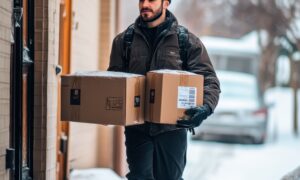
With a full schedule and a strict budget to maintain, it can be hard to plan a month in advance — let alone the future. But the reality is climate change is already impacting how SaverLife members think about their next steps.
In a recent survey, 52% of SaverLife members shared that they’ve experienced severe weather like a flood or frequent storms, while 71% have experienced poor air quality. These learnings suggest that, for many SaverLife members, the question of climate change is no longer “if” they’ll be impacted, but “when?”
At SaverLife, we believe there’s no one way to prepare for climate change. Your choices should make sense for your budget and long-term goals. However, if you’re looking to protect your finances during and after a climate disaster, consider this article the first step in your plan.
Read on to learn how to respond to severe weather and maintain financial stability right after a weather event occurs.
Meet Your Immediate Needs
In the aftermath of a climate disaster, you may need to meet immediate needs like securing safe shelter and food for yourself and your family.
If you need temporary shelter, check with FEMA to see if their Individuals and Household Programs can offer you any assistance. They have programs that provide financial assistance for temporary housing as well as programs that provide temporary housing units.
Additionally, you can contact your insurance company and request an advance on your claim. Often homeowner policies cover “loss of use.” This means they will provide funds to cover expenses beyond your normal housing expenses. You can use these funds to rent a hotel room if your home only needs minor repairs or an apartment if you will be out of your home for much longer. As you look for assistance and places to live, be mindful of price gouging and report it if you see it.
Prior to a natural disaster, it can be helpful to stock up on at least one week’s worth of nonperishable food. This could include granola and protein bars, dried fruit, cereal or granola, ready-to-eat canned foods (and a can opener), infant food and formula, and any other foods your family might need. These can be useful during and after the climate disaster, especially if the power is cut off.
To get help with buying food after a natural disaster, you may qualify for D-SNAP (Disaster Supplemental Nutrition Assistance Program). Like SNAP, this program provides money on an EBT (Electronic Benefit Transfer) card that can be used to purchase food. To learn more and see if you qualify, visit https://www.usa.gov/disaster-food-help.
Plan for Your Transportation Needs
In the wake of a disaster, public transportation may be less consistent or not run at all. This can be challenging if you rely on public transportation to get to work or to the grocery store.
Consider your transportation needs and try to anticipate how they may change during and after a natural disaster to be sure you’re ready. You may even need to set aside emergency money to cover additional transportation costs.
Apply for Assistance
If you find yourself affected by a climate disaster and need assistance paying your bills, it’s important to ask for help. Getting outside help can preserve your credit and get you back on your feet.
Visit FEMA’s Disaster Assistance website to find information regarding which resources and assistance programs you qualify for. Depending on your needs, you may also be able to get help in applying for assistance programs.
You can also look for assistance programs provided by the state you live in or your local community.
Contact Lenders and Bank
If you don’t have the funds needed to keep up with financial obligations after a climate disaster, reach out to your lenders or bank to see if they can provide additional support.
Contact both your mortgage servicer and your credit card companies to discuss what options are available.
In addition to your mortgage service and credit card companies, you’ll also want to reach out to your bank and any other companies that send you bills. If you have bills on autopay, working with your bank to stop the automatic payments can help ensure that you don’t overdraw your account. Reaching out to companies like your utility company or streaming services to suspend your account can also help you save money that you might need for other expenses or bills.
File Claims with Your Insurance Company
If you have property that’s been lost or damaged during a climate disaster, it’s important to file a claim with your insurance company. If your damaged property is covered by your insurance, you can replace or receive a reimbursement for it.
If you don’t have your policy information, don’t panic. Contact your insurance company for a copy of your policy.
Be sure to take pictures and videos of the damaged property once it’s safe to do so. This helps to document the situation for your claim. Ask the insurance company what additional information they need from you to complete your claims, and do your best to get it to them in a timely manner.
Keep your receipts when you spend money on food, lodging, or construction supplies. You might be entitled to additional reimbursements for some of these expenses, depending on your insurance policy.
Look Out for Scams
In times of disaster, you’ll often find neighbors and community members ready to lend a hand. But these events also come with an increased risk of scams.
If you’re looking for help rebuilding, think critically about who you hire to help. If someone wants payment upfront for a service, benefit, or loan; is selling services door-to-door; or offers you a limited-time offer, they might be a scammer trying to benefit from the crisis.
Ask questions about the person, the business, or the entity they claim to work for. These questions can include things like asking for references, confirming how long the company has been in business, or requesting to see their contractor’s license.
If you’re worried the person trying to sell you services may be a con artist, ask for identification and call the company to verify that the individual works there. Never give out your bank account or other financial information to strangers.
Final Thoughts
Climate change is the fight of our lives. Why? Because it’s already impacting how we navigate our daily realities, especially for people living on low-to-moderate incomes.
But this doesn’t mean that you should have to make a tradeoff between preparing for severe weather and achieving your financial health goals. Take small steps where you can to plan and protect yourself, your family, and your finances.


